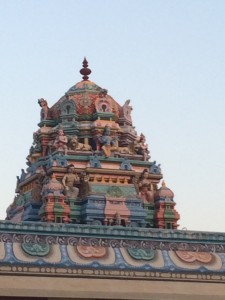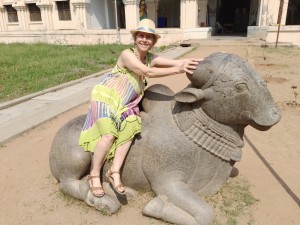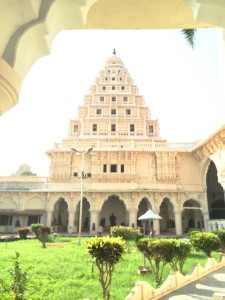TEMPLE RUN
What an unfun blogslog it would be to conduct a didactic step-by-step tour of each Hindu temple we’ve visited. Not going to happen here, so it’s safe to keep reading.
You don’t need a doctorate to tell a lot about the Hindus just by looking at the outside of the temples.
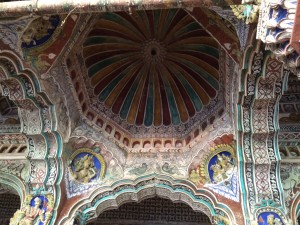 They like color. The paint on the reliefs and statues is vivid and riotous. They’re not afraid of humor. Ganesh, for example, the elephant-head god (that’s worth a chuckle right there.) is a laughing big eater with a belly to match. There are comical guys with big mustaches and swords and stomachs to match guarding the gods. And the sensuality is rampant, with the standard goddess possessed of big boobs and hips and slim waists, often dressed in jeweled belts that take a triangular dive under the belly pointing to, ahem, (all designed by men, of course), and the ability to assume the most outrageous poses.
They like color. The paint on the reliefs and statues is vivid and riotous. They’re not afraid of humor. Ganesh, for example, the elephant-head god (that’s worth a chuckle right there.) is a laughing big eater with a belly to match. There are comical guys with big mustaches and swords and stomachs to match guarding the gods. And the sensuality is rampant, with the standard goddess possessed of big boobs and hips and slim waists, often dressed in jeweled belts that take a triangular dive under the belly pointing to, ahem, (all designed by men, of course), and the ability to assume the most outrageous poses.
And The gods consort with animals a lot.
 You can tell there’s a wide pantheon of gods, each of whom has a wide variety of arms to carry out its functions and use its powers effectively.
You can tell there’s a wide pantheon of gods, each of whom has a wide variety of arms to carry out its functions and use its powers effectively.
Hindus like their temples big when they can get them that way, though many, many lesser temples are scattered around the countryside. The temples are more than houses of worship. They are community centers. Parks. Social and economic engines for their communities. Muslim and Hindu families both gather for recreation and socializing. The temples sacred on the one hand and public monuments with purpose for everyone in the community on the other.
Inside, though, it’s a different story. You won’t find a wide open space of the kind that typifies a standard mosque, nor will you find the ordered, focused architecture of a Christian cathedral, designed to raise your eyes and soul forward and upward to the cross and to the heavens and the priest. Imagine a Christian cathedral with no main altar, no grand windows, no elegant pillars topped with gold leaf, and no pews.
Instead, you get raw stone, often smoky with the fires of centuries. Instead of little chapels tucked away neatly in alcoves at the sides of the nave, you get chapels scattered throughout a maze of hallways. Within the chapels, the image/statue of the god it represents is often tucked so far back from the hallway that you can hardly make it out, the idea being that ordinary mortals wouldn’t be able to stand looking it in the eye. And I have no pictures to offer here because they weren’t allowed.
People make offerings of flowers, money, etc. The priests carry it to the altar. Rituals are performed several times per day, and multiple services may be going on simultaneously, even at the smaller temples, like the one dedicated to the dangerous goddess Kali, whose temples always sit outside a city because it’s too risky to have her close by.
Of the several rituals at the several temples we’ve seen, the most extraordinary one took us quite close because of a connection our tour leader has with one of the monks. It was a homage to the god Siva, the destroyer. The statue itself sat well back as described above, and several priests focused on the lingam, or phallic representation of the god, carved out of pure crystal. It sat in a yonic receptacle of the female the god’s female aspect. They chanted and sang and danced, seemingly moving without order, but always with purpose, pouring libations, smashing coconuts and scattering the shells and milk here and there as sacrifices.
At one point, the priests drew a curtain, did a lot of chanting behind it, then they opened the curtain, and there the lingam was, covered in rice. They passed the rice around among them, each of them taking a few grains in his mouth, including one young lady who seemed to be present as an observer. That done, they abluted the object some more, then lighted a fire in a dish, which they took back to the chamber which housed the god-image. They passed the fire in a circle near the statue several times, investing the fire with holy strength then returned to the assembled and passed the fire among us. We each passed our hands through it and placed hands on our face, investing ourselves with the spirit. After that, we received from a priest a mark of ash on our foreheads, then a red dot. White for cool, red for heat, or semen and blood, respectively. Then bells rang deafeningly and chanting continued.
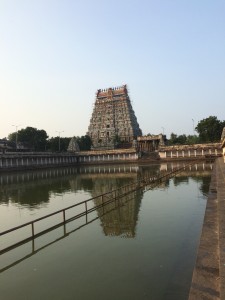 our priest friend showed us around, one stop being the temple bath–a huge pool for the faithful to gather in and purify themselves. it was such a big pond there were fish in it. He was an extremely nice man, who blessed us again and wished us long life and peace. As we walked, other services continued around us. He conducts the service six times a day, the number being no accident, but I don’t recall the reason. In fact, if Martin, our tour guide, hadn’t prepared us with stories and lectures before we entered, we would have found the whole thing completely chaotic and could have made no sense of it whatsoever. I’m sure others who were there would describe the whole event entirely differently. Apparently, that’s the idea. Both the Hindu architecture and the service are supposed to take you out of your comfort zone, unsettle you, and turn your head and soul around, and leave you inspired in some totally new way.
our priest friend showed us around, one stop being the temple bath–a huge pool for the faithful to gather in and purify themselves. it was such a big pond there were fish in it. He was an extremely nice man, who blessed us again and wished us long life and peace. As we walked, other services continued around us. He conducts the service six times a day, the number being no accident, but I don’t recall the reason. In fact, if Martin, our tour guide, hadn’t prepared us with stories and lectures before we entered, we would have found the whole thing completely chaotic and could have made no sense of it whatsoever. I’m sure others who were there would describe the whole event entirely differently. Apparently, that’s the idea. Both the Hindu architecture and the service are supposed to take you out of your comfort zone, unsettle you, and turn your head and soul around, and leave you inspired in some totally new way.
Mission accomplished.
Friday, 9 January – Swamimalai
Thanjavur (Tanjore)
Monday and Tuesday, 12 and 13 January – Chettinad (Karaikudi)
KARAIKUDI SOUTH INDIA, TAMILNADU
SOUTH INDIA: TAMIL NADU’S TEMPLE CITIES, KERALA’S BACKWATERS and SPICE COUNTRY at Pongal Festival Time
A Cultural Heritage Trip with Carol and Martin Noval
5 to 25 January 2015
Itinerary:
Monday, 5 January – Chennai (Madras)
A car and driver will meet you on your arrival at the Chennai International airport. Check-in time for the trip will be at 12 noon on 5 January. We will meet for lunch at noon and after lunch we will tour the historic Fort area with its fabulous British Raj period buildings. We will stroll in the neighborhood of the Kapileshwar Temple, a traditional “village” in the heart of Chennai. In the late afternoon-evening, we will attend an Indian classical music or dance performance.
Residency Towers Hotel
Please note: as most international flights arrive in India in the late night/early morning you may want to arrive in Chennai by the night of 4/5 January. We can arrange extra nights for you in our Chennai hotel.
Tuesday and Wednesday, 6 and 7 January – Mamallapuram
A pleasant 2-hour drive on the coastal highway brings us to Mamallapuram. More than 2000 years ago, Mamallapuram, on India’s southeast coast, was already a famous seaport, but it was in the mid-7th century AD during the rule of the kings Mahendravarman and Mamalla I of the Pallava dynasty that the town became the base for the export of Indian culture to Southeast Asia and a hub of commerce in the flourishing Indian Ocean trade. And it was also in that century that numerous monuments were built, or rather carved out of the boulders that abound in this area; they include caves, monolithic temples and large sculpted reliefs. Mamallapuram is a stone city cut from living rock. The vibrancy and animation of the art created here during the Pallava ascendancy is unsurpassed anywhere. Most impressive and unforgettable is a giant sculptural relief that is so perfectly ambivalent it can be interpreted to represent two entirely different mythological tales. 100 feet long, it teems with human, animal and plant figures all in life size.
We attend an outdoor dance performance performed against the backdrop of the monolithic relief of the “Descent of the Ganges.”
GRT Temple Bay Resort, on the beach
Thursday, 8 January – Chidambaram
Pondicherry, a one-time French colonial outpost, lies on our route. The town still retains a dash of Gallic character, but with an Indian flavor, a charming cultural incongruity. We’ll have a look at the town when we stop there for lunch en route to Chidambaram.
“I could never believe in a god who doesn’t dance,” said a famous 19th-century Western philosopher. Chidambaram is the home of Dancing Shiva – Nataraja, the king of dancers. Enclosed by four concentric walls pierced by monumental gateways, teeming with sculptures of gods, demons and sundry celestial beings, the temple contains innumerable shrines, an enormous ritual bathing tank, a thousand-pillared hall (where musicians perform) and vast colonnaded corridors. Within the innermost enclosure, the “palace” of the dancing god is a gold-roofed pavilion. We are escorted in the temple by a member of the clan of hereditary Dikshitar priests, and have special access to secret recesses of the temple.
Vandayar Hotel
Friday, 9 January – Swamimalai
Morning visit to the Kali Aman Temple in Chidambaram, an awesome image of Kali is the central object of worship. It’s a 2-hour drive from Chidambaram to Swamimalai. After lunch it’s a half-hour drive to Kumbakonam. Built around a large water pool containing a few drops of the nectar of immortality, the town is famous for its Chola dynasty temples, one of them containing masterpieces of 9th-century stone sculpture on the walls of its sanctuary — beautiful, elegant and so life-like they appear to stand free of their wall niches. Another temple has a gigantic stone Vishnu reclining on a serpent sofa and floating on the cosmic ocean as he prepares once again to create the world, and a wonderful 11-story gateway covered in polychromatic mythical figures.
Mantra Veppathur Resort
Saturday and Sunday, 10 and 11 January – Thanjavur (Tanjore)
Visit a bronze workshop in Swamimalai where sacred images are fashioned using the lost-wax process, exactly as they were 1200 years ago. After lunch drive to Thanjavur. The main town in the Kaveri (Cauvery) River delta, Tamil Nadu’s rice bowl, Thanjavur was the 11th-century capital of the greatest Chola king, Rajaraja I. Here he built the Brihadesvara temple, South India’s major architectural monument. Completed with a great concentration of effort in an amazingly short time (seven years at the beginning of the 11th century), this towering structure has over its central sanctum a pyramidal stone “vimana” that rises in 14 tiers to more than 200 feet. Its cupola is an 80-ton block of granite that was hauled to the top of the tower along a 4-mile long earthen ramp. When it was built, this temple was probably the world’s largest building. A huge monolithic Nandi — Shiva’s bull vehicle — crouches outside the temple’s entrance and gazes devotedly at the gigantic Shiva lingam that is the temple’s main object of worship. Stone sculptures three times life size fill niches in the temple’s outer walls. Set amid beautiful lawns in a spacious compound, the changing colors of the buildings at dusk are magical. Here, of an evening, the people of Thanjavur gather on the lawns to socialize and enjoy the ambience of the nighttime illumination. At the entrance, an elephant blesses devotees, gently tapping them on the head with his trunk.
Hotel Parisutham
Monday and Tuesday, 12 and 13 January – Chettinad (Karaikudi)
Driving through ageless countryside, we stop at an out-of-the-way cave temple set among massive boulders. Karaikudi is a traditional town dominated by the Chettiars, one of India’s closest-knit and wealthiest business communities. When ancient Tamil kingdoms colonized Southeast Asia, it was the Chettiars who dominated trade, finance and banking; their business connections spread throughout India and as far afield as China. In Karaikudi and the villages around it, the Chettiars established their estates, constructing opulent mansions, which were inhabited by the Chettiar women and children while the men were away pursuing their fortunes; nowadays, these houses are used for only a few weeks each year when families gather for reunions. The houses are built with Burmese teak doors, thresholds and pillars, and floored with unique locally-made tiles. We will visit a few of the outstanding ones and a tile factory where special hand-made tiles are made; we’ll also visit weavers who produce the distinctive cotton cloth of the region on wooden looms.
We stay in the Bangala, a delightful renovated art deco “club house,” where the leading lights of the community met when they were in town; it is still operated by members of the family that built it, and the food is authentic Chettinad cuisine, some of the most delicious regional food of India.
Wednesday, 14 January – Madurai
Established by a king of the Pandya dynasty in the 6th century BC, the city’s name means “nectar,” for here a few drops of the elixir of immortality fell from the god Shiva’s locks when he came here to marry Minakshi, the fish-eyed goddess. Indeed, the temple here, India’s second largest, was built to celebrate that marriage.
The temple complex has 11 massive gateways. Rising from high granite bases, the tapering brick and stucco superstructures swarm with life-size colorful sculpted figures. Actually a twin temple, one sanctuary is dedicated to Shiva, here called Sundaresvara (the beautiful god), and the other to his consort, Minakshi. Within the walls is a huge tank (the tank of the golden lilies) surrounded by steps and a pillared portico. The long and enormous pillared corridors, halls and shrine areas of the temple contain a bewildering array of heavily ornamented monumentally sculpted figures that dwarf the devotees. Although carved from hard granite, the rendering of detail is exquisite and each figure has its own character and individuality. For such a vast project, an incredible standard of artistic excellence has been maintained throughout the complex.
Temples in Tamil Nadu are more than simply places of worship but major centers of economic, social, cultural and religious life, virtually cities in themselves with market places, banks and orchestras; and in Madurai, the markets overflow the temple compound into the streets and lanes, which surround the temple like petals around a lotus’s center.
GRT Residency
Thursday, Friday and Saturday, 15, 16 and 17 January – Periyar Wildlife Sanctuary
From Madurai, we drive through lush farmland and plantations up into the hills of Kerala. Like many of India’s wildlife sanctuaries, Periyar too belonged to a maharaja, but with a difference. The raja abhorred hunting from the start, and when an English hunter killed an elephant (a sacred animal for Hindus) on his land, the raja declared a ban on hunting, thereby creating India’s first wildlife preserve. In addition, the British constructed a dam across the Periyar River flooding the lower reaches of the raja’s forests, but at the same time creating a vast lake and making Periyar Sanctuary wonderfully picturesque. For the animals, the lake provides a perennial supply of water and the forest, a protective cover. In the park there are herds of elephants, Indian bison, monkeys, wild dogs, otters, deer, sloth bears, giant and flying squirrels, flying lizards, snakes and tigers too, as well as an array of birds including hornbills, kingfishers, cormorants and darters.
We view wildlife comfortably from a small launch and on walks in the forest. The area around Periyar is the heart of the spice-growing region and we visit a spice garden and see how spices are grown in harmony with the natural surroundings. We have a home-cooked lunch at the owner’s home.
Aranya Nivas Lodge, right inside the park.
Sunday and Monday, 18 and 19 January – Alapuzha (Alleppy) and the Backwaters
Kerala’s backwaters were formed by deposits of sand and silt — brought down the mountains by Kerala’s numerous rivers — in long banks parallel to the Arabian Sea.
We stay at a backwaters resort and cruise the backwaters by houseboat and country boat. We explore the quaint village on foot and visit an ancient goddess temple. Here people live their lives on the canals; coconut trees border vast green rice paddies, which lie below water level; we have the strange sensation of boating above the land.
Emerald Isle Heritage Backwaters Resort
Tuesday and Wednesday, 20 and 21 January – Kochi (Cochin)
Kerala’s spices lured to its ports the ships of the Phoenicians, King Solomon, the Selucid Syrians, the Ptolomies of Egypt, Greeks, Arabs, Romans and Chinese. Vasco da Gama, after rounding South Africa’s Cape of Good Hope, landed midway along Kerala’s coast at Calicut (which gave its name to the cotton fabric we know as Calico) in 1498. The local ruler, the Zamorin, was very forthright: “In my country there is an abundance of cinnamon, cloves, pepper and precious stones. What I seek from thy country is gold, silver, coral…” The European states (Portugal, Holland, France and England) rushed to Kerala to supply it to him. (Had not these states been able to loot the precious metals of the Americas to exchange for Kerala’s spices, the trade with India would have bankrupted them, for the Europeans had nothing of their own that the East desired.)
In 1341, a great flood swept over the coast of central Kerala, creating a wasteland of alluvial deposits where once ancient Muziris, western India’s greatest seaport, was located. But that same storm carved out of the land a great natural harbor barely 35 miles south of Muziris. In short order, this port, Cochin, became the hub of India’s west coast sea trade. The profile of Fort Cochin’s waterfront with its residential buildings, churches, warehouses, trading companies’ headquarters, commercial establishments and the enormous cantilevered, Chinese fishing nets looks today very much as it did in the 17th, 18th and 19th centuries. Here where the spicy wealth of India reached the sea, Indian rulers and the colonial powers vied for commercial and military advantage.
Here also, immigrants from the Middle East (Jews and Muslims), Africa and Europe settled to take advantage of the opportunities created by this concentration of wealth. The city is composed of narrow spits of land that jut out into a wide bay, and one of them, Fort Cochin, remains as it was, a “colonial” spice trading port, a living museum. There is a palace built in the 16th century by the Portuguese and gifted to the Raja of Cochin and then rebuilt and re-gifted by the Dutch. It contains a remarkable series of murals of Hindu mythological scenes. Also built in that century is the Jewish synagogue. With a population of around 4000 at its peak, the so-called white Jews, who spoke fluent Malayalam (the language of Kerala), were lynchpins in the spice trade and received local as well as Dutch and English patronage. (There was also a community of “black” Jews who came to Kerala perhaps as early as the time of King Solomon (ca. 1030 BC). The synagogue, a beautiful light and airy building, has 18th-century blue ceramic Cantonese tiles on its floor, each hand painted with a different design. There are also two notable churches and the fascinating Chinese fishing nets, great cantilevered contraptions introduced by Chinese traders in the 14th century.
We explore Fort Cochin on foot and attend a performance of traditional Kerala dance.
We stay in the heart of Fort Cochin
Le Colonial Heritage Hotel.
Thursday, Friday and Saturday, 22, 23 and 24 January – Mumbai (Bombay) by air
We take a midday flight from Cochin to Mumbai. Situated on India’s west coast on what were once seven islands, the name Mumbai is derived from Mumbadevi, patron goddess of a caste of fisherfolk, the area’s original inhabitants. Hindus, Muslims, Christians and Parsis (Zoroastrians) all have a major presence here. Mumbai is today India’s throbbing and vibrant commercial capital and still a stately colonial city.
We explore the leafy streets of the Fort, the well-preserved colonial heritage area of town with its beautiful neo-Gothic buildings of British trading houses, Bombay University, and Victoria Railway Station, affectionately known as “VT,” now a World Heritage site. The vast colonial Gothic railway station has richly carved buttresses, domes, turrets, spires and stained glass windows.
From the Gateway of India — a triumphal arch built to commemorate the visit of King George V in 1911 — we board a private boat and cruise for an hour to an island, Elephanta, where rock-cut caves carved between the 5th and 8th centuries AD contain remarkable sculptures depicting the god Shiva and his consort Parvati. Emerging from a recess in the back wall of the vast main cave is a 20-foot high image of three-faced Shiva. Its central face, stone become animate, expresses the fullness of absolute knowledge that is peace. This is one of the great masterpieces of world art.
We stay in executive sea-facing rooms at the Hotel Sea Palace, a boutique hotel on the sea front.
Saturday, 25 January – Depart India
Check out is at noon.
The price of the 2015 South India trip is $5990 per person (single supplement $1500) and it includes all accommodation (with attached bath), all meals, mineral water and soft drinks, entrance fees and admissions, land travel in A/C buses or cars, the flight from Cochin to Mumbai, boat rides, all airport transfers and is based on double occupancy and a group size of 10 members. Carol and Martin guide you throughout the trip.

